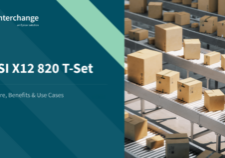Why Scalable EDI is Integral to Rapid Business Growth
EDI is integral to B2B communication and logistics, and there’s a reason why it’s continued to successfully adapt to our ever-changing global supply chains for 60 years.
Technology has to support your business as it grows to meet rising customer demand, but solutions often hit the end of their lifespan sooner than you’d like. This fuels the risk-averse nature of many businesses, as they’re tired of investing in solutions that don’t serve them long-term. As a result, the long-lasting success and adaptability of EDI have driven its popularity amongst these organisations.
Today, businesses across all industries use EDI, including newly formed SMBs and SMEs seeking to conduct frictionless trade with global partners.1 Over 70% of B2B transactions are facilitated by EDI, largely due to the influence of EDI-mature businesses such as Walmart, Amazon, Target, and Ford.2
Modern EDI has become increasingly flexible and scalable, supporting various formats, protocols, and integrations via API. This is excellent news for emerging businesses seeking to integrate with EDI-mature partners with established integration preferences.
In this blog, we’ll delve into why scalable EDI is integral to driving business growth.
Suggested reading: Check out our eBook, Agile Supply Chain, to learn more about how to make your supply chains work for you.

Streamlined communication
EDI utilises peer-to-peer communication to streamline data exchange – this is one of the technology’s fundamental features and where it continues to thrive.
By trading data in mutually agreed, standard formats, businesses can eradicate human error and remove frictions associated with trading, such as manually issuing and receiving purchasing orders (POs), invoices, shipping mandates, etc.
- EDI swaps cumbersome paper documents for semi-automated and automated workflows.
- EDI simplifies the transfer and exchange of large, complex business documents.
- Logging and audit trails ensure transparency.
The exchange of POs and invoices is a prime example. When stock is running low, a purchasing order can be generated and sent via EDI in a standard format to the supplier. The supplier automatically returns an invoice to the buyer. EDI facilitates the process via a secure connection with minimal human input.
Scale up those processes to thousands or even millions of documents per day, week, or year, and you can see how EDI becomes a necessity rather than a ‘nice to have’.
Scalable EDI supports numerous standards and protocols
Standards and protocols are the primary gears and mechanisms behind EDI.
Scalable EDI solutions provide extensive support for standards such as EDIFACT, VDA, TRADACOMS, and PEPPOL, and file transfer protocols, for example, OFTP2, AS2, SFTP, and FTP. Some protocols are broad, such as the UN-developed EDIFACT, whereas others are considerably more specific, like VDA for the German automotive industry.
Value-added networks (VANs) facilitate a single connection to trading partners with support for numerous standards and protocols. You can often access a VAN through a third-party EDI expert such as Data Interchange, who manages your EDI implementation on their VAN, DiNet.
A single, secure connection is all that’s required to trade with a huge range of partners across virtually any standard or protocol. Scalable EDI solutions aren’t limited by protocols and standards and can adapt to virtually any trading situation.
Suggested reading: We talk more about the different communications protocols and how they streamline communication in our blog, A Guide to EDI Protocols.
Improved compliance
In EDI terms, EDI compliance involves complying with partners’ trading requirements and specifications. Most industries, such as manufacturing, construction, healthcare, pharma, etc, have preferences for specific EDI industry standards and protocols. Standards also differ geographically (e.g. X12 in North America and EDIFACT in Europe).
Large EDI-mature businesses like Tesco and Amazon mandate their EDI requirements on suppliers, who have little choice but to adapt. If businesses can’t cater to requirements, they cannot compete with those who can.
By adopting flexible EDI, businesses can effectively:
- Advertise their integration credentials to prospective partners.
- Outcompete those that don’t offer rapid integration.
- Rid themselves of the stress and resources of organising a last-minute integration.
- Deliver expected outcomes without hindrance or delay.
- Strike up long-term collaborative partnerships.
In short, newer SMBs and SMEs looking to trade with established businesses must adapt to meet partners’ integration specifications. This perpetuates the use of EDI, as established businesses already have a winning formula. After all, huge retailers like we mentioned above all use EDI for a reason – it just works.
It’s perhaps unsurprising, then, that research shows that recent gains in EDI adoption are largely attributed to smaller businesses looking to integrate with established buyers.3
Scalable EDI is adaptable to partner requirements
Smaller businesses must adapt to their partners’ needs with minimal friction and onboarding.
Competing for business requires a can-do attitude which modern EDI solutions deliver via VANs and simplified integration methods. Despite being a veteran B2B technology, EDI has evolved to offer WebEDI, Managed EDI, and EDI-as-a-Service, which further alleviate the friction of integrating with new partners.
For example, WebEDI allows buyers and suppliers to integrate and manage documents via their web browsers, whereas managed services support the end-to-end integration process to match the requirements of complex supply chains.
In other words, businesses no longer require extensive internal skills and resources to adopt and manage cutting-edge solutions, which is ideal for SMBs and SMEs looking to integrate with a wider pool of established partners.
Reduced costs
Modern logistics is fast and furious, and any opportunity to reduce costs and accelerate business cycles is firmly welcomed. A study ranked the top 5 benefits of EDI adoption:
- Increased document accuracy.
- Increased efficiency.
- Increased business cycle speed.
- Maintain or gain competitive advantages.
- Reduced inventory costs.4
As you can see, reducing costs, improving speed, and staying ahead of the competition aren’t just priorities your business holds — they’re what’s driving the logistics sector. A specific area in which EDI can reduce costs is by enabling just-in-time (JIT) inventory management.
JIT vastly accelerates business cycles, but it also reduces holding costs. Since stock is delivered as and when required, businesses can lean out their warehousing requirements and cut associated costs. Studies highlight the complementary nature of EDI and JIT, as EDI handles the smooth data exchange that JIT depends on.5
Seamless integration of businesses via EDI is mutually beneficial, as inventory is moved promptly and delivered as and when it’s required with minimal friction or delay.
Scalable EDI saves time and cuts costs
State-of-the-art logistics workflows built with modern EDI cut costs by accelerating business cycles. By investing in a scalable EDI solution, businesses can reduce inventory costs and advertise their credibility to prospective partners.
Additionally, you can use APIs to integrate EDI with your ERP. In turn, businesses can create sophisticated pipelines that modernise their supply chain management with support from other technologies, such as IoT, Big Data data analytics, and more.
Improved operational efficiency
If your business is running into bottlenecks in its supply chains, that could result in deals falling through and massive losses of income. This often drives businesses to be risk-averse and hesitant to try different technology solutions.
However, in order to scale effectively, businesses must allocate time and resources to mission-critical tasks and rely on technology for automated processes like data transfers. EDI supports this by automating time-intensive workflows and reducing manual work.
EDI provides many benefits which boost operational efficiency:
- Transparency and tracking: EDI is transparent and auditable, which prevents data from getting lost. Keep communication on track to avoid lengthy fact-finding missions when things go wrong.
- Reduced labour: Any reduction in manual data entry reduces costs and boosts efficiency. This is something EDI does very well by automating some of the most time-consuming processes of conducting business with global partners.
- Automation: Intelligent use of EDI and integration with other software like ERPs helps businesses create automated data pipelines.
Scalable EDI enhances efficiency
Flexible EDI enables a whole host of automated workflows which level up a business’s logistical capabilities, which is essential in an industry where minutes and even seconds count.
Cutting-edge services such as WebEDI and EDI-as-a-service allow businesses to unlock competitive advantages without the need to build their own internal EDI functions.
Driving business growth with Data Interchange
EDI has adapted to the rigours and demands of global supply chains and continues to drive business growth — networking buyers and suppliers with streamlined B2B communication solutions. Next-gen EDI services like WebEDI and API integrations are modernising supply chains, cutting costs, driving efficiency, and opening new opportunities for innovation.
Scalable EDI with Data Interchange
Scalable EDI enables rapid business growth, but choosing, implementing, and managing a seamless EDI solution isn’t always easy. This is why working with a trusted EDI partner is crucial.
Data Interchange has developed pioneering B2B communication technology for over 35 years. Our suite of cutting-edge EDI products is designed for modern supply chains, from our sophisticated VAN, DiNet, to our extensible B2B getaway, Odex.
In addition to providing the tools businesses need to modernise their supply chains, Data Interchange offers managed services that help businesses tap into the state-of-art EDI they need to thrive and grow.
Contact us today to find out how our EDI software and services can support you.




























































































































